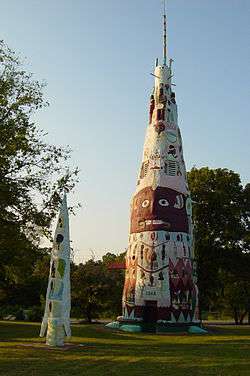Ed Galloway's Totem Pole Park
|
Ed Galloway's Totem Pole Park | |
 Ed Galloway's Totem Pole Park | |
 | |
| Nearest city | Foyil, Oklahoma |
|---|---|
| Coordinates | 36°26′14″N 95°26′53″W / 36.43722°N 95.44806°WCoordinates: 36°26′14″N 95°26′53″W / 36.43722°N 95.44806°W |
| Area | 1.4 acres (0.57 ha) |
| Built | 1937 |
| Architect | Nathan Edward Galloway |
| NRHP reference # | 99000354[1] |
| Added to NRHP | March 30, 1999 |
Ed Galloway's Totem Pole Park consists of eleven objects and one building on 14 acres (57,000 m²) in Rogers County, in northeastern Oklahoma. The park is ten miles (16 km) north-east of Claremore and is located 3.5 miles (6 km) east of historic U.S. Route 66 and Foyil. It was added to the National Register of Historic Places on March 30, 1999. It is owned and operated by the Rogers County Historical Society and the Foyil Heritage Association. The park's main totem pole is claimed to be the "World’s Largest Concrete Totem Pole."[2]
History and creation
The park was constructed by Ed Galloway, a retired manual arts teacher who had taught for more than 20 years at the Children's Home orphanage in Sand Springs, Oklahoma.[3] Upon his retirement, Galloway moved to a small farm near Foyil.[3] His property is located ten miles (16 km) north-east of Claremore and is located 3.5 miles (6 km) east of historic U.S. Route 66
He soon began work there on a totem pole, which he built using modern building materials, including six tons of steel, 28 tons of cement, and 100 tons of sand and rock.[3] In 1948, Galloway completed the totem pole,[2] which had a completed height of approximately 90 ft (27 m).[3] At its base, the totem pole is 30 ft (9 m) wide, and it rests on the back of a turtle, referring to a Native American creation story about the world.[3][4] The entire totem pole is decorated with approximately 200 bas relief images, which include brightly colored Native American portraits, symbols, and animal figures.[3]
The park also features Galloway’s eleven-sided "Fiddle House", which is supported inside and out by 25 concrete totem poles. It previously housed his hand-carved fiddles, handmade furniture, and bas relief portraits of all of the US Presidents up to John F. Kennedy. Many of the items in the Fiddle House were stolen in 1970 and never recovered. The park also contains four smaller concrete totems, two ornate concrete picnic tables with animal-form seats, a barbecue, and four sets of animal-form gateposts.
Galloway lived at and worked on the park every day up to his death in 1962 of cancer. Some say that he hoped to use his work to educate young people about Native Americans, but others say that he thought the park would be a good place for youngsters, Boy Scouts in particular, to visit.
Renovation
In the decades following Galloway’s death, the sculptures began to deteriorate from weather and neglect. In the 1990s, the Kansas Grassroots Art Association led an extensive restoration effort.[2] The outdoor sculptures were restored and repainted, and the Fiddle House was brought back from the brink of collapse. It was adapted as the Fiddle House Museum and Gift Shop. The park and its structures are owned and operated by the Rogers County Historical Society and the Foyil Heritage Association.
References
- ↑ National Park Service (2009-03-13). "National Register Information System". National Register of Historic Places. National Park Service.
- 1 2 3 Covington, Hannah. "Childhood friends, artists bring color back to historic totem pole," Tulsa World, 30 July 2015; Accessed 30 July 2015.
- 1 2 3 4 5 6 "Ed Galloway - Creator of the World's Largest Totem Pole", Rogers County Historical Society, Accessed August 4, 2015.
- ↑ "Totem Pole Park," TravelOK, Oklahoma Tourism and Recreation Department. Accessed July 30, 2015.
External links
- Ed Galloway's Totem Pole Park - Rogers County Historical Society
- Ed Galloway's Totem Pole Park - Ed Galloway's Totem Pole Park
- Totem Pole Park info, photos and video on TravelOK.com - Official travel and tourism website for the State of Oklahoma
- Roadside American Report on Ed Galloway's Totem Pole Park